Xiongkuo Min
VQualA 2025 Challenge on Visual Quality Comparison for Large Multimodal Models: Methods and Results
Sep 11, 2025

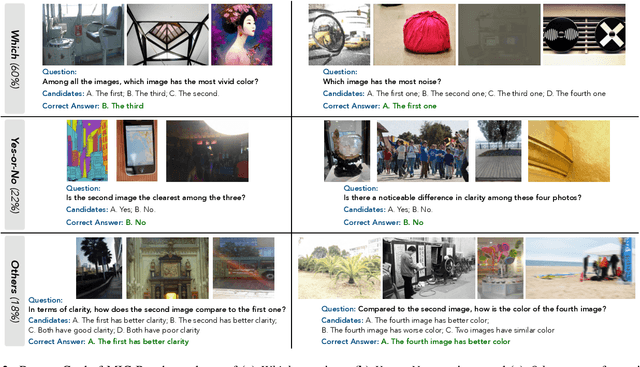
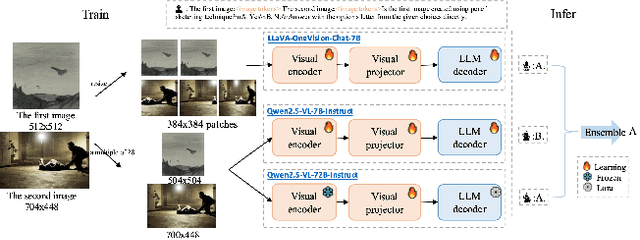
Abstract:This paper presents a summary of the VQualA 2025 Challenge on Visual Quality Comparison for Large Multimodal Models (LMMs), hosted as part of the ICCV 2025 Workshop on Visual Quality Assessment. The challenge aims to evaluate and enhance the ability of state-of-the-art LMMs to perform open-ended and detailed reasoning about visual quality differences across multiple images. To this end, the competition introduces a novel benchmark comprising thousands of coarse-to-fine grained visual quality comparison tasks, spanning single images, pairs, and multi-image groups. Each task requires models to provide accurate quality judgments. The competition emphasizes holistic evaluation protocols, including 2AFC-based binary preference and multi-choice questions (MCQs). Around 100 participants submitted entries, with five models demonstrating the emerging capabilities of instruction-tuned LMMs on quality assessment. This challenge marks a significant step toward open-domain visual quality reasoning and comparison and serves as a catalyst for future research on interpretable and human-aligned quality evaluation systems.
Audio-Assisted Face Video Restoration with Temporal and Identity Complementary Learning
Aug 06, 2025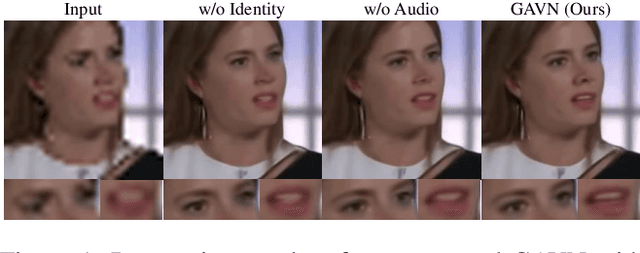
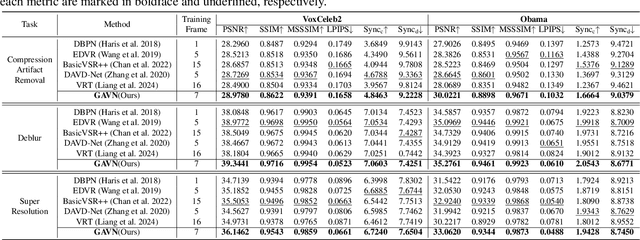
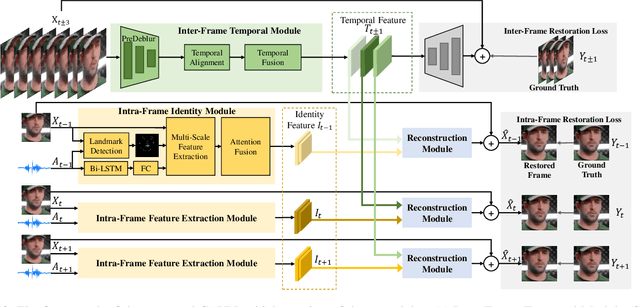
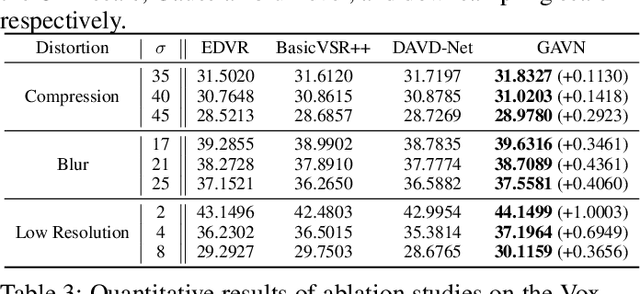
Abstract:Face videos accompanied by audio have become integral to our daily lives, while they often suffer from complex degradations. Most face video restoration methods neglect the intrinsic correlations between the visual and audio features, especially in mouth regions. A few audio-aided face video restoration methods have been proposed, but they only focus on compression artifact removal. In this paper, we propose a General Audio-assisted face Video restoration Network (GAVN) to address various types of streaming video distortions via identity and temporal complementary learning. Specifically, GAVN first captures inter-frame temporal features in the low-resolution space to restore frames coarsely and save computational cost. Then, GAVN extracts intra-frame identity features in the high-resolution space with the assistance of audio signals and face landmarks to restore more facial details. Finally, the reconstruction module integrates temporal features and identity features to generate high-quality face videos. Experimental results demonstrate that GAVN outperforms the existing state-of-the-art methods on face video compression artifact removal, deblurring, and super-resolution. Codes will be released upon publication.
CompressedVQA-HDR: Generalized Full-reference and No-reference Quality Assessment Models for Compressed High Dynamic Range Videos
Jul 16, 2025Abstract:Video compression is a standard procedure applied to all videos to minimize storage and transmission demands while preserving visual quality as much as possible. Therefore, evaluating the visual quality of compressed videos is crucial for guiding the practical usage and further development of video compression algorithms. Although numerous compressed video quality assessment (VQA) methods have been proposed, they often lack the generalization capability needed to handle the increasing diversity of video types, particularly high dynamic range (HDR) content. In this paper, we introduce CompressedVQA-HDR, an effective VQA framework designed to address the challenges of HDR video quality assessment. Specifically, we adopt the Swin Transformer and SigLip 2 as the backbone networks for the proposed full-reference (FR) and no-reference (NR) VQA models, respectively. For the FR model, we compute deep structural and textural similarities between reference and distorted frames using intermediate-layer features extracted from the Swin Transformer as its quality-aware feature representation. For the NR model, we extract the global mean of the final-layer feature maps from SigLip 2 as its quality-aware representation. To mitigate the issue of limited HDR training data, we pre-train the FR model on a large-scale standard dynamic range (SDR) VQA dataset and fine-tune it on the HDRSDR-VQA dataset. For the NR model, we employ an iterative mixed-dataset training strategy across multiple compressed VQA datasets, followed by fine-tuning on the HDRSDR-VQA dataset. Experimental results show that our models achieve state-of-the-art performance compared to existing FR and NR VQA models. Moreover, CompressedVQA-HDR-FR won first place in the FR track of the Generalizable HDR & SDR Video Quality Measurement Grand Challenge at IEEE ICME 2025. The code is available at https://github.com/sunwei925/CompressedVQA-HDR.
Scaling-up Perceptual Video Quality Assessment
May 28, 2025Abstract:The data scaling law has been shown to significantly enhance the performance of large multi-modal models (LMMs) across various downstream tasks. However, in the domain of perceptual video quality assessment (VQA), the potential of scaling law remains unprecedented due to the scarcity of labeled resources and the insufficient scale of datasets. To address this, we propose \textbf{OmniVQA}, an efficient framework designed to efficiently build high-quality, human-in-the-loop VQA multi-modal instruction databases (MIDBs). We then scale up to create \textbf{OmniVQA-Chat-400K}, the largest MIDB in the VQA field concurrently. Our focus is on the technical and aesthetic quality dimensions, with abundant in-context instruction data to provide fine-grained VQA knowledge. Additionally, we have built the \textbf{OmniVQA-MOS-20K} dataset to enhance the model's quantitative quality rating capabilities. We then introduce a \textbf{complementary} training strategy that effectively leverages the knowledge from datasets for quality understanding and quality rating tasks. Furthermore, we propose the \textbf{OmniVQA-FG (fine-grain)-Benchmark} to evaluate the fine-grained performance of the models. Our results demonstrate that our models achieve state-of-the-art performance in both quality understanding and rating tasks.
TDVE-Assessor: Benchmarking and Evaluating the Quality of Text-Driven Video Editing with LMMs
May 26, 2025Abstract:Text-driven video editing is rapidly advancing, yet its rigorous evaluation remains challenging due to the absence of dedicated video quality assessment (VQA) models capable of discerning the nuances of editing quality. To address this critical gap, we introduce TDVE-DB, a large-scale benchmark dataset for text-driven video editing. TDVE-DB consists of 3,857 edited videos generated from 12 diverse models across 8 editing categories, and is annotated with 173,565 human subjective ratings along three crucial dimensions, i.e., edited video quality, editing alignment, and structural consistency. Based on TDVE-DB, we first conduct a comprehensive evaluation for the 12 state-of-the-art editing models revealing the strengths and weaknesses of current video techniques, and then benchmark existing VQA methods in the context of text-driven video editing evaluation. Building on these insights, we propose TDVE-Assessor, a novel VQA model specifically designed for text-driven video editing assessment. TDVE-Assessor integrates both spatial and temporal video features into a large language model (LLM) for rich contextual understanding to provide comprehensive quality assessment. Extensive experiments demonstrate that TDVE-Assessor substantially outperforms existing VQA models on TDVE-DB across all three evaluation dimensions, setting a new state-of-the-art. Both TDVE-DB and TDVE-Assessor will be released upon the publication.
NTIRE 2025 challenge on Text to Image Generation Model Quality Assessment
May 22, 2025Abstract:This paper reports on the NTIRE 2025 challenge on Text to Image (T2I) generation model quality assessment, which will be held in conjunction with the New Trends in Image Restoration and Enhancement Workshop (NTIRE) at CVPR 2025. The aim of this challenge is to address the fine-grained quality assessment of text-to-image generation models. This challenge evaluates text-to-image models from two aspects: image-text alignment and image structural distortion detection, and is divided into the alignment track and the structural track. The alignment track uses the EvalMuse-40K, which contains around 40K AI-Generated Images (AIGIs) generated by 20 popular generative models. The alignment track has a total of 371 registered participants. A total of 1,883 submissions are received in the development phase, and 507 submissions are received in the test phase. Finally, 12 participating teams submitted their models and fact sheets. The structure track uses the EvalMuse-Structure, which contains 10,000 AI-Generated Images (AIGIs) with corresponding structural distortion mask. A total of 211 participants have registered in the structure track. A total of 1155 submissions are received in the development phase, and 487 submissions are received in the test phase. Finally, 8 participating teams submitted their models and fact sheets. Almost all methods have achieved better results than baseline methods, and the winning methods in both tracks have demonstrated superior prediction performance on T2I model quality assessment.
Exploring Image Quality Assessment from a New Perspective: Pupil Size
May 20, 2025Abstract:This paper explores how the image quality assessment (IQA) task affects the cognitive processes of people from the perspective of pupil size and studies the relationship between pupil size and image quality. Specifically, we first invited subjects to participate in a subjective experiment, which includes two tasks: free observation and IQA. In the free observation task, subjects did not need to perform any action, and they only needed to observe images as they usually do with an album. In the IQA task, subjects were required to score images according to their overall impression of image quality. Then, by analyzing the difference in pupil size between the two tasks, we find that people may activate the visual attention mechanism when evaluating image quality. Meanwhile, we also find that the change in pupil size is closely related to image quality in the IQA task. For future research on IQA, this research can not only provide a theoretical basis for the objective IQA method and promote the development of more effective objective IQA methods, but also provide a new subjective IQA method for collecting the authentic subjective impression of image quality.
LOVE: Benchmarking and Evaluating Text-to-Video Generation and Video-to-Text Interpretation
May 17, 2025Abstract:Recent advancements in large multimodal models (LMMs) have driven substantial progress in both text-to-video (T2V) generation and video-to-text (V2T) interpretation tasks. However, current AI-generated videos (AIGVs) still exhibit limitations in terms of perceptual quality and text-video alignment. Therefore, a reliable and scalable automatic model for AIGV evaluation is desirable, which heavily relies on the scale and quality of human annotations. To this end, we present AIGVE-60K, a comprehensive dataset and benchmark for AI-Generated Video Evaluation, which features (i) comprehensive tasks, encompassing 3,050 extensive prompts across 20 fine-grained task dimensions, (ii) the largest human annotations, including 120K mean-opinion scores (MOSs) and 60K question-answering (QA) pairs annotated on 58,500 videos generated from 30 T2V models, and (iii) bidirectional benchmarking and evaluating for both T2V generation and V2T interpretation capabilities. Based on AIGVE-60K, we propose LOVE, a LMM-based metric for AIGV Evaluation from multiple dimensions including perceptual preference, text-video correspondence, and task-specific accuracy in terms of both instance level and model level. Comprehensive experiments demonstrate that LOVE not only achieves state-of-the-art performance on the AIGVE-60K dataset, but also generalizes effectively to a wide range of other AIGV evaluation benchmarks. These findings highlight the significance of the AIGVE-60K dataset. Database and codes are anonymously available at https://github.com/IntMeGroup/LOVE.
Breaking Annotation Barriers: Generalized Video Quality Assessment via Ranking-based Self-Supervision
May 07, 2025Abstract:Video quality assessment (VQA) is essential for quantifying perceptual quality in various video processing workflows, spanning from camera capture systems to over-the-top streaming platforms. While recent supervised VQA models have made substantial progress, the reliance on manually annotated datasets -- a process that is labor-intensive, costly, and difficult to scale up -- has hindered further optimization of their generalization to unseen video content and distortions. To bridge this gap, we introduce a self-supervised learning framework for VQA to learn quality assessment capabilities from large-scale, unlabeled web videos. Our approach leverages a \textbf{learning-to-rank} paradigm to train a large multimodal model (LMM) on video pairs automatically labeled via two manners, including quality pseudo-labeling by existing VQA models and relative quality ranking based on synthetic distortion simulations. Furthermore, we introduce a novel \textbf{iterative self-improvement training strategy}, where the trained model acts an improved annotator to iteratively refine the annotation quality of training data. By training on a dataset $10\times$ larger than the existing VQA benchmarks, our model: (1) achieves zero-shot performance on in-domain VQA benchmarks that matches or surpasses supervised models; (2) demonstrates superior out-of-distribution (OOD) generalization across diverse video content and distortions; and (3) sets a new state-of-the-art when fine-tuned on human-labeled datasets. Extensive experimental results validate the effectiveness of our self-supervised approach in training generalized VQA models. The datasets and code will be publicly released to facilitate future research.
LMME3DHF: Benchmarking and Evaluating Multimodal 3D Human Face Generation with LMMs
May 05, 2025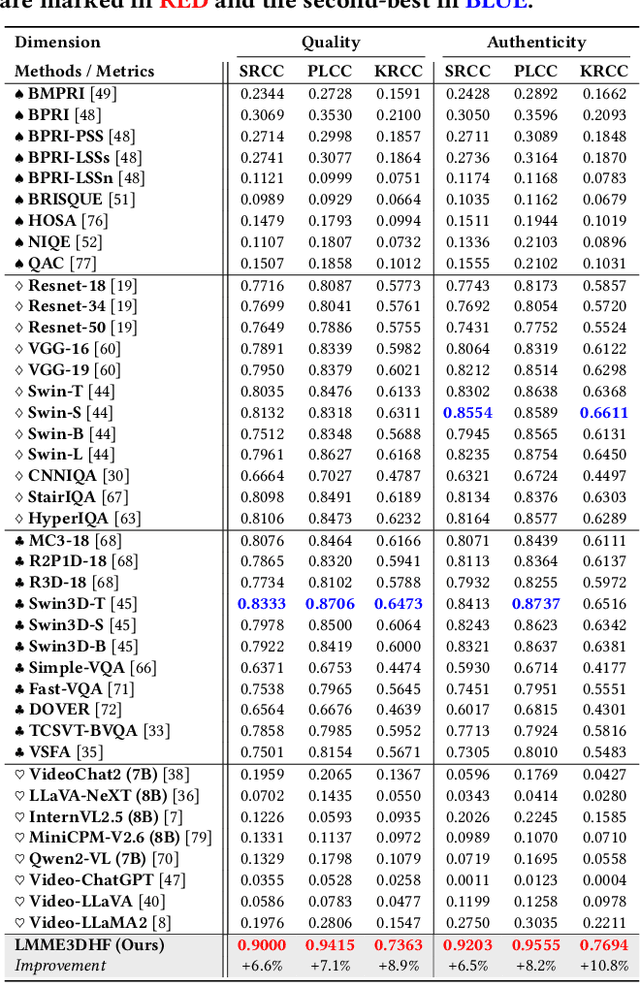

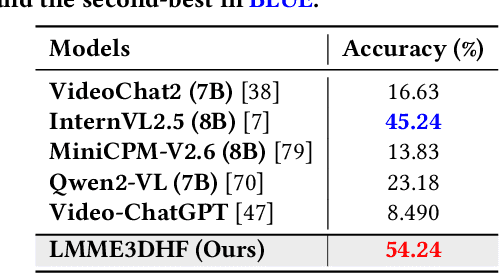

Abstract:The rapid advancement in generative artificial intelligence have enabled the creation of 3D human faces (HFs) for applications including media production, virtual reality, security, healthcare, and game development, etc. However, assessing the quality and realism of these AI-generated 3D human faces remains a significant challenge due to the subjective nature of human perception and innate perceptual sensitivity to facial features. To this end, we conduct a comprehensive study on the quality assessment of AI-generated 3D human faces. We first introduce Gen3DHF, a large-scale benchmark comprising 2,000 videos of AI-Generated 3D Human Faces along with 4,000 Mean Opinion Scores (MOS) collected across two dimensions, i.e., quality and authenticity, 2,000 distortion-aware saliency maps and distortion descriptions. Based on Gen3DHF, we propose LMME3DHF, a Large Multimodal Model (LMM)-based metric for Evaluating 3DHF capable of quality and authenticity score prediction, distortion-aware visual question answering, and distortion-aware saliency prediction. Experimental results show that LMME3DHF achieves state-of-the-art performance, surpassing existing methods in both accurately predicting quality scores for AI-generated 3D human faces and effectively identifying distortion-aware salient regions and distortion types, while maintaining strong alignment with human perceptual judgments. Both the Gen3DHF database and the LMME3DHF will be released upon the publication.
 Add to Chrome
Add to Chrome Add to Firefox
Add to Firefox Add to Edge
Add to Edge